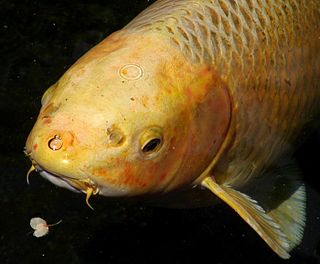
Nototheniidae, the notothens or cod icefishes, is a family of ray-finned fishes, part of the suborder Notothenioidei which is traditionally placed within the order Perciformes. They are largely found in the Southern Ocean.

Notothenioidei is one of 19 suborders of the order Perciformes. The group is found mainly in Antarctic and Subantarctic waters, with some species ranging north to southern Australia and southern South America. Notothenioids constitute approximately 90% of the fish biomass in the continental shelf waters surrounding Antarctica.

Bovichtidae, the temperate icefishes or thornfishes, is a family of marine ray-finned fishes, classified in the suborder Notothenioidei of the order Perciformes. They are native to coastal waters off Australia, New Zealand, and South America.

In fish anatomy and turtle anatomy, a barbel is a slender, whiskerlike sensory organ near the mouth. Fish that have barbels include the catfish, the carp, the goatfish, the hagfish, the sturgeon, the zebrafish, the black dragonfish and some species of shark such as the sawshark. Barbels house the taste buds of such fish and are used to search for food in murky water.

The Artedidraconidae, barbeled plunderfishes, are a family of marine ray-finned fishes, notothenioids belonging to the Perciform suborder Notothenioidei. The family comprises four genera. These fishes are endemic to deep waters off Antarctica.

Harpagifer, the spiny plunderfishes is a genus of marine ray-finned fishes, belonging to the family Harpagiferidae, it is the only genus in this monotypic family. They are found in the Southern Ocean.

Paranotothenia magellanica, also known as Magellanic rockcod, Maori cod, blue notothenia or orange throat notothen, is a species of marine ray-finned fish, belonging to the family Nototheniidae, the notothens or cod icefishes. It is native to the Southern Ocean. "Maori chief" and "black cod", sometimes used for this species, usually refer to fishes from the related genus Notothenia. Being a perciform fish, it is unrelated to the true cods of the order Gadiformes. This species is commercially important as a food fish.
Genioliparis is a genus of marine ray-finned fishes belonging to the family Liparidae, the snailfishes. These fishes are found in the Pacific and Southern Oceans.
Volodichthys is a genus of snailfishes found in deep water, more than 750 m (2,460 ft), of southern oceans near Antarctica and southern South America. Its members were formerly included in the genus Careproctus.

Artedidraco is a genus of marine ray-finned fishes belonging to the family Artedidraconidae, the barbeled plunderfishes. They are native to the Southern Ocean.

Dolloidraco is a monotypic genus of marine ray-finned fish, its only known species being Dolloidraco longedorsalis, belonging to the family Artedidraconidae, the barbeled plunderfishes. It is native to the Southern Ocean in the waters around Antarctica.

Histiodraco is a monotypic genus of marine ray-finned fish, its only known species being Histiodraco velifer, belonging to the family Artedidraconidae, the barbeled plunderfishes. It is native to the Southern Ocean and the waters around Antarctica.
Vomeridens is a monotypic genus of marine ray-finned fish belonging to the family Bathydraconidae, the Antarctic dragonfishes, its only species is Vomeridens infuscipinnis. These fishes are native to the Southern Ocean.

Bovichtus is a genus of fish in the family Bovichtidae found in the Atlantic, Indian and Pacific Ocean.
The flathead congoli is a species of marine ray-finned fish, belonging to the family Bovichtidae, the thornfishes or temperate icefishes. It is native to the seas off southeastern Australia. This species is the only known member of its genus.

Channichthys is a genus of marine ray-finned fish belonging to the family Channichthyidae, the crocodile icefishes. They are native to the Southern Ocean.

Cryodraco is a genus of marine ray-finned fish belonging to the family Channichthyidae, the crocodile icefishes. They are found in the Southern Ocean. While C. antarcticus has minor commercial importance, C. atkinsoni and C. pappenheimi are of no interest to commercial fisheries.

Trematomus is a genus of marine ray-finned fishes, belonging to the family Nototheniidae, the notothens or cod icefishes. These fishes occur in the Southern Ocean.

Channichthys panticapaei, the charcoal icefish, is a species of marine ray-finned fish belonging to the family Channichthyidae, the crocodile icefishes. It is endemic to the Kerguelen Islands area in the Southern Ocean. This demersal species is found at depths of 112–154 m (367–505 ft) and is sometimes caught in bottom trawls. However, it is not targeted and is of no interest to commercial fisheries at present. It is dark gray to uniformly blackish with long first to third dorsal fin spines. The charcoal icefish reaches lengths of up to 40.2 cm (15.8 in), with females generally being smaller. This planktivorous (plankton-eating) species likely spawns from June to July, with maturity reached at 30 cm TL / 27 cm SL.

Gvozdarus svetovidovi, the naked-head toothfish, is a species of marine ray-finned fish belonging to the family Nototheniidae, the notothens or cod icefishes. It is found in the Ross and Cooperation Seas, probably south of the Antarctic Polar Front from pelagic waters down to depths of 550 m (1,804 ft), though it is normally found in a pelagic environment.















